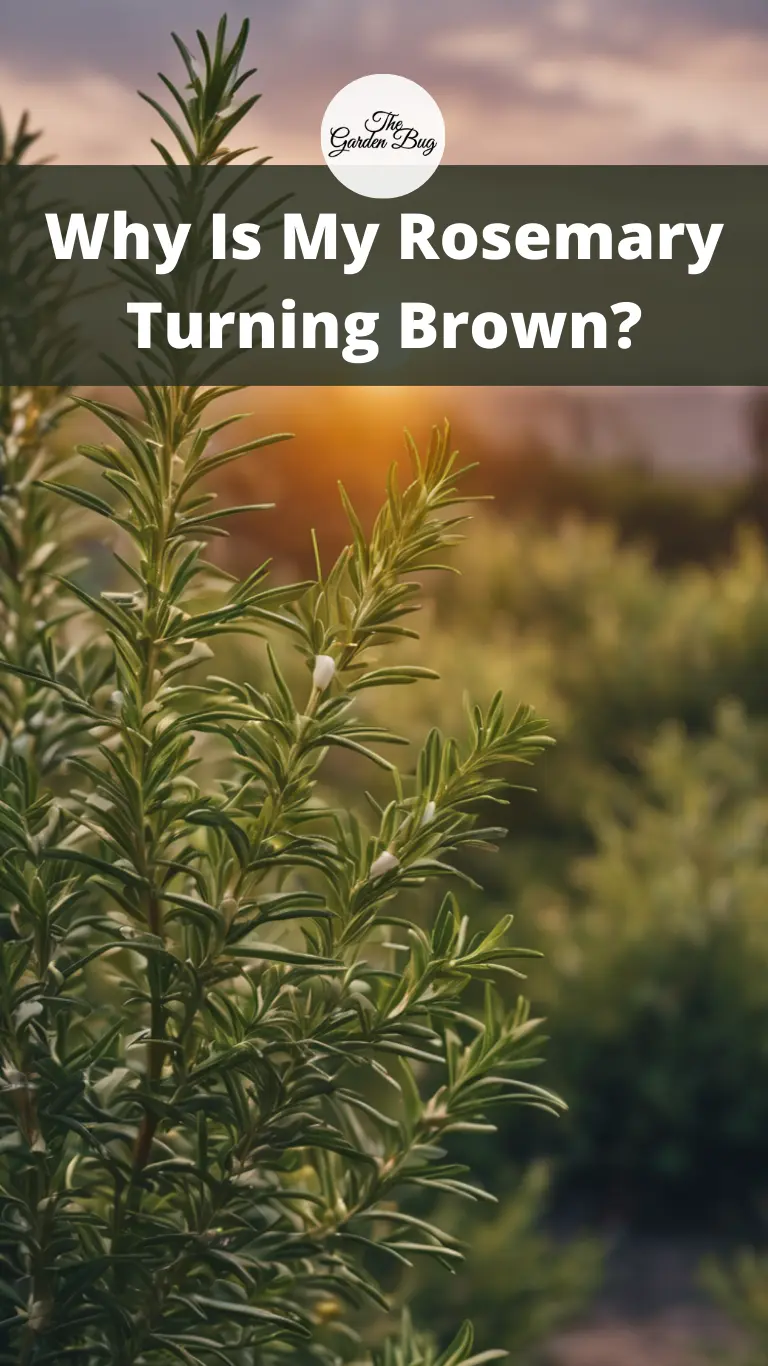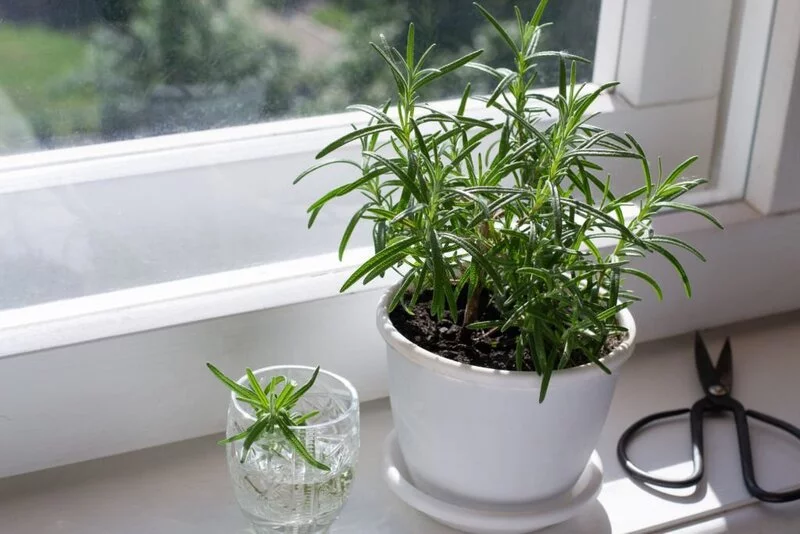You’ve been lovingly tending to your rosemary plant, and then, seemingly out of nowhere, its fragrant green leaves start to turn brown. It’s disheartening, and you’re left wondering: why is this happening? What can I do to fix it? Don’t fret, dear plant parent. This guide is here to help you understand what might be going wrong and how to set it right.
- Tiny, strongly aromatic & flavorful leaves, blue blooms
- Garden use: Herb garden, flower border, containers, low clipped hedge
- Culinary use: Italian & Mediterranean dishes, vinegars & oils, breads
- Plant in full sun for the best yields
- Plant during spring & fall
Understanding Rosemary Plants
Rosemary is a popular herb known for its fragrant, needle-like leaves and delicate blue flowers. It’s a tough, resilient plant that brings a lot of flavor to our cooking and a lot of beauty to our gardens.
Native to the Mediterranean, rosemary thrives in sunny climates and well-draining soil. It loves full sun and can tolerate dry conditions, reflecting its seaside origins. However, even though it’s a hardy plant, rosemary is not immune to issues. It can sometimes turn brown due to a range of factors, from water problems to diseases or pests.
Common Reasons Why Rosemary Turns Brown
Rosemary, as rugged as it is, can sometimes find life a bit challenging. Here are some reasons why your rosemary might be turning brown:
- Overwatering or Underwatering: Rosemary plants love well-draining soil and can easily become unhappy if they’re sitting in water or not getting enough of it. Overwatering can cause root rot, while underwatering can dry the plant out, both leading to brown leaves.
- Lack of Sunlight: Rosemary plants are sun lovers. If they don’t get enough sunlight, they can start to lose their vibrant green color and turn brown.
- Disease: Various diseases, such as powdery mildew or root rot, can cause your rosemary’s leaves to turn brown.
- Pests: Certain pests like spider mites or aphids can damage the leaves of your rosemary plant, causing them to turn brown.
- Temperature Stress: Extreme temperatures, whether hot or cold, can cause stress to your rosemary plant, leading to browning leaves.
- FRESH SCENT: EcoSmart’s Natural Garden Insect Killer kills garden pests by contact with the help of plant essential oils, such as Rosemary Oil and Peppermint Oil, so there is no overbearing, harsh chemical smell- only a fresh scent and no bugs
- ENVIRONMENTALLY FRIENDLY: Our natural, plant-based formula is safe to use on ornamentals, shrubs, flowers, small trees, vegetables and fruit crops (household use only), but won’t harm fish, wildlife and does not contaminate groundwater supplies
- CHILD AND PET FRIENDLY: Safe to use around children and pets (when used as directed)
- NO CHEMICALS: Take chemicals out of your lawn, garden and home equation with EcoSmart
- MADE IN THE USA
How to Diagnose the Problem
The first step in rescuing your browning rosemary plant is figuring out what’s causing the problem. Here’s how you can play plant detective:
- Check the Watering: Feel the soil. If it’s too dry or too wet, you might have found the culprit.
- Observe Sunlight Conditions: Is your rosemary in a spot where it gets at least six hours of sunlight a day? If not, it might be craving more light.
- Inspect for Diseases: Look for other signs of disease like spots, mildew, or unusual leaf drop.
- Look for Pests: Check the underside of the leaves. If you see tiny bugs or webs, pests might be the issue.
- Assess Temperature Conditions: Has there been a recent heatwave, cold snap, or drastic temperature change? This might have caused stress to your plant.
By thoroughly inspecting your plant and its environment, you can identify what might be causing your rosemary to turn brown and take the necessary steps to bring it back to its vibrant self.
Solutions for Brown Rosemary
Now that we’ve identified the potential culprits, it’s time to nurse your brown rosemary back to health:
- Watering: Make sure you’re watering your rosemary just right. The soil should be moist, not soggy. If you’ve been overwatering, cut back. If you’ve been underwatering, give your plant a good soak.
- Sunlight: If your rosemary isn’t getting enough sun, consider moving it to a sunnier spot where it will get at least six hours of sunlight a day.
- Disease: If disease is the issue, you might need to use a fungicide or change the way you’re caring for your plant. Consult a local nursery or extension service for advice specific to your situation.
- Pests: If pests are bothering your plant, consider using an insecticidal soap or a natural pest control method like introducing beneficial insects.
- Temperature: If extreme temperatures are to blame, try to relocate your plant to a more temperate spot. Remember, rosemary prefers milder temperatures, not too hot or too cold.
Preventing Future Browning
Prevention is better than cure, they say, and they’re right. Here are some tips to prevent your rosemary from turning brown in the future:
- Water Properly: Water your rosemary when the top inch of soil is dry, and make sure the pot or garden bed has good drainage.
- Provide Ample Sunlight: Position your rosemary plant in a spot where it gets plenty of sunlight.
- Regular Inspection: Keep a close eye on your plant for any signs of disease or pests so you can act quickly if needed.
- Care for the Soil: Make sure your rosemary is planted in well-draining soil. Consider adding some organic matter to improve the soil’s structure and drainage.
- Protect from Extreme Weather: During very hot or cold weather, consider moving potted plants indoors or providing some protection to outdoor plants.
- NUTRIENT RICH & INDOOR/OUTDOOR FAST GERMINATION… Wonder Soil Premium Organic Potting Soil Mix is the only dry compressed coco coir mix with added amendments of worm castings, mycorrhizae, kelp, perlite and more! Grow your plants faster with stronger roots! Peat free, all natural, family and pet safe!
- A LITTLE DOES A LOT… your little BIG bag of compressed indoor potting soil & garden soil for outdoor plants expands to 4 TIMES THE SIZE when mixed with water; easy to carry & saves vital shed space.
- PRE-MIXED & READY TO USE ORGANIC POTTING MIX … Pre-mixed and ready to use organic potting soil and garden soil mix to help make your gardening or hobby growing a breeze. Simply transplant your desired plants into their new container and add our soil mix or pour our soil mix and plant your seeds.
- WATER RETENTION & DRAINAGE… Coco coir has excellent water retention with dependable drainage and aeration in the root zone. Save up to 50% of water, fertilizer, and seed!
- HEAVY DUTY RESEALABLE BAG… Use what you need and save the rest for later! Keeping your planting soil dry and safe!
With these tips, your rosemary should be well on its way to bouncing back from its brown phase and thriving once again. Here’s to many more years of fragrant and delicious rosemary from your garden!
Frequently Asked Questions
Now let’s address some common questions people often have about caring for their rosemary plants:
- Can a brown rosemary plant turn green again? Yes, it’s possible if the problem is caught early enough and the right measures are taken.
- How often should I water my rosemary plant? Water your rosemary when the top inch of soil is dry. The frequency can vary depending on climate, soil, and pot size, so it’s best to check the soil regularly.
- Can rosemary plants survive indoors? Yes, they can! However, they need plenty of sunlight and humidity, so a sunny windowsill and regular misting can help them thrive.
- Why are the tips of my rosemary turning brown? This could be due to a variety of issues, including overwatering, underwatering, too much sun, not enough sun, disease, or pests. It’s important to investigate and address the specific issue your plant might be facing.
Conclusion
A brown rosemary plant might seem like a gardening disaster, but don’t lose hope. With the right care, attention, and a little plant TLC, you can nurse it back to its fragrant, green self. Remember, the key to successful plant care is understanding your plant’s needs and responding to any signs of distress promptly. We hope this guide gives you the confidence to do just that. Keep growing and enjoy the rewards of your green thumb!








